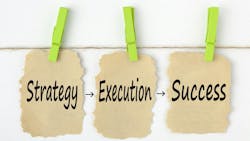Quality Should Be a Strategic Lever, Not Just Compliance
Key Highlights
- Quality should be integrated from the start of product development to prevent redesigns and reduce time-to-market.
- Utilize real-time signals and layered inspection systems to detect early signs of process instability and prevent defects.
- Embed quality KPIs across functions to foster collaboration, shared ownership and continuous improvement.
- Connect quality metrics directly to financial outcomes like COPQ and contract margins to inform strategic decisions.
Quality is a critical function that often lags behind digital transformation and efficiency. Too frequently, quality is treated as a support function, necessary, but peripheral. That mindset is a liability.
In my 15+ years leading quality and engineering for global manufacturers in automotive, industrial and renewable energy, I have seen quality evolve from a passive cost center to a proactive performance driver. However, that transformation only occurs when leadership recognizes quality as a strategic lever, not just a compliance requirement.
The Strategic Misconception
Manufacturing teams operate in increasingly complex, fast-moving environments. Product life cycles are shorter, supply chains more fragile and customer expectations higher. Yet, inspection systems and quality protocols often rely on outdated methods: manual audits, lagging indicators and quality metrics disconnected from business outcomes.
At a plant manufacturing aluminum parts for autonomous EVs, I inherited an inspection process that generated inconsistent results. Defects were often identified late, and investigations frequently focused on assigning responsibility rather than addressing the root cause.
We replaced this outdated approach with structured inspection routines, integrated feedback between design and production, and proactive monitoring of tooling wear. Defect rates fell, but more importantly, team alignment improved.
This wasn’t just an equipment upgrade; it was a shift in mindset.
A New Role for Quality Leaders
Quality must evolve from a function that merely identifies problems to one that serves a critical role in solving issues systematically. That means moving from detection to decision support.
At a manufacturer of high-performance products, we developed a quality system that flagged deviations and linked them to commercial risk, such as delivery delays, contract penalties and warranty exposure. This data informed senior-level decisions about vendor strategy, capacity planning and capital investment.
When quality data becomes a part of leadership dashboards and not just audit reports, it changes the direction, tying quality performance to financial impact.
A Practical Framework for Quality Leadership
To reposition quality as a leadership function, executives should adopt four strategic pillars:
1. Integration. Quality must be involved in projects from day one, starting with product development and supplier selection. Early engagement with quality engineers can prevent redesigns, reduce scrap and accelerate customer validation, significantly reducing timelines and paving the way for growth and success.
2. Intelligence. Most quality systems track defects, but few interpret them. At the diecasting plant, we established a layered inspection system linked to real-time signals, including process drift, tooling-wear trends and tolerance-level shifts. This allowed us to detect early signs of instability and adjust before failures occurred. Intelligence doesn't mean more data; it means more useful data.
3. Involvement. Quality cannot operate in isolation. During my tenure at a solar-tracker manufacturer, we embedded quality KPIs across production, maintenance, engineering and logistics, ensuring that each function had ownership of its outcomes. With that ownership, problems were addressed collaboratively, not defensively, and teams developed a shared commitment to stability and performance.
4. Impact. Quality metrics must be connected to financial outcomes. At the high-performance manufacturer, we linked rework, inspection time and scrap rates to the cost of poor quality (COPQ) and contract margin erosion. This allowed senior leadership to prioritize corrective actions and justify capital expenditure with real return on investment.
Why Managers Should Care
The companies that win in volatile markets will not be the ones with the fastest machines, but the ones that make the fewest mistakes and quickest recovery. That requires quality systems that are:
- Predictive: anticipating issues, not just responding to them
- Visible: shared across functions, not siloed in inspection reports
- Actionable: tied to decision-making, not just compliance. When quality data is used to make strategic decisions, it empowers leaders and teams, giving them a sense of control over the business's direction.
Leadership plays a central role in enabling a quality-driven environment. When leaders demand insight, traceability and system thinking, they make their teams feel valued and integral to the business's success.
Getting Started With Quality as a Strategy
For leaders seeking to elevate quality in their organizations, here are three actions to start with:
1. Audit decision latency. How long does it take your teams to detect a defect, understand its root cause and respond? Shorten that loop through a unified defect classification and empowering operator with first-response authority to contain issues immediately and drive sustained quality improvement
2. Tie quality to strategy. Review how often quality metrics inform sourcing, hiring, investment or customer-retention decisions. If the answer is “rarely,” there’s an opportunity to elevate quality into strategic decision-making. For example, rather than adding more inspectors when defects increase:
- Designate an engineer or consultant to help eliminate root causes
- Shift volume to suppliers with stronger process capability instead of simply the lowest price to reduce warranty risk and total cost of ownership
- Incorporate a quality-to-strategy scorecard into quarterly business reviews to show how quality improvements drive financial impact and customer value.
This approach demonstrates year-over-year improvement and strengthens long-term customer trust.
3. Invest in capability, not just compliance. Train teams to interpret variation, manage uncertainty and collaborate across functions, not just follow checklists.
These are management decisions, not technical ones.
From Compliance to Competitive Advantage
Quality is no longer just about avoiding defects. It’s about building systems that enhance resilience, earn trust and accelerate innovation. That transformation starts at the top of the organization.
I’ve seen what happens when executives make that shift and when they don’t. Organizations that view quality as a strategic asset outperform those that treat it as routine. They move faster, spend smarter and are more adaptive.
The next wave of competitive advantage in manufacturing won’t come from hardware or software alone. It will come from organizations that lead with quality by design.
About the Author

Venkata Ravi Kumar Jonnalagadda
Venkata Ravi Kumar Jonnalagadda is an engineering and quality leader with over 15 years of experience in materials engineering, die casting, renewable energy systems, and large-scale manufacturing operations. He has led cross-functional teams to improve product reliability, reduce the cost of poor quality, and enhance supplier performance across global supply chains. His efforts have supported the growth of clean energy and industrial infrastructure, including the deployment of high-performance structural components and solar tracking systems.
